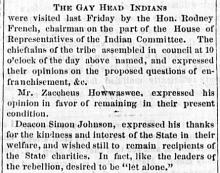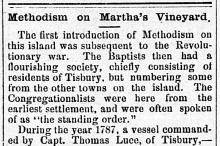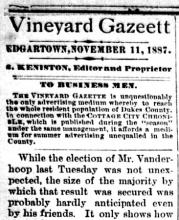“Yea, those of the Isles of Capawack sent to make friendship.” With these words, Governor Bradford, recording in his history, “Of Plimouth Plantation”, a moral triumph over the surrounding savages, singles out for mention by name the most dreaded tribe under Massasoit, Sachem of the Warmanoag, of southern Massachusetts.
In the decade before the Pilgrims became acquainted with Capawack, the island had a peculiar fascination for English explorers. Captain John Smith, in particular, writes of “Capawack, and those abounding countries of copper, corn, people, minerals”, as though he were thinking of Capawack as the key to the Indian kingdom described by Verrazano in his letter of 1524, published by Hakluyt in England in 1584. If the half of what that enthusiastic Florentine had reported to the French king were true, the country he placed at 41° 40’ was well worth finding.
The history of the island in this period is a series of intriguing glimpses gleaned from the records of the explorers, following Gosnold, who sought it. So far as is known, the first to reach the island after Gosnold, was Captain Edward Harlow, a former officer of the short-lived Popham colony in Maine. His “Relation” has not survived, but fortunately John Smith abstracted a few brief sentences from it in his Generall Historie.
“Supposed About Cape Cod”
Some two or three years prior to 1614, Harlow was employed by the Earl of Southhampton and others to find an island “supposed about Cape Cod”, — obviously the one discovered by Gosnold, whose expedition had been in part financed by the same earl. Smith, presumably quoting Harlow, reports that “they found no isle but the main”. Beyond this, Smith takes from the “Relation” only a few sentences naming the Indians captured. On the Main, presumably Pawmet, they “detained” three, one of whom escaped. On the Isle of Nohono (possibly a confused form for Nantucket), where the Indians attacked them, they took one captive. Next, “At Capawe, they took Coneconam and Epenow, but the people at Agawam used them kindly. So with five savages they returned for England.” If the Agawam mentioned is Wareham, and not the more familiar one at Ipswich, it means that Harlow sailed through the Sounds and up to the head of Buzzard’s Bay, as Gosnold had done.
In this scanty report, appears the name of Epenow, an Indian of significance in the history of Capawack. His story is told officially in the Briefe Relation, issued by the Council of New Enlgland, and additional, essential details are given by Dermer, Smith and Gorges. Reconstructed from these sources, the tale is as follows.
This captive from Capawack had been exhibited in London as a wonder by Captain Harlow. Gorges describes Epenow as “a goodly man, of a brave aspect, stout, and sober in his demeanor”. Smith speaks of him as great in stature. He had learned enough English to say “Welcome, welcome!” to those who came to gape at his bronze color and powerful physique. (Gorges mistakenly says that Epenow was one taken on the mainland in a raid by a Captain Hunt; Epenow was on the high seas, on the way home, when that raid was made.)
Harlow was presently persuaded that there was a better use to be made of his captive. He took Epenow to Sir Ferdinando Gorges with a proposal, the nature of which Gorges tried to keep from the public, but which is frankly revealed by John Smith. Epenow had promised to show his captors where gold was to be found on Capawack, if he were returned to his home.
Financing the Voyage
Gorges consulted the Earl of Southampton, who for the third time was willing to finance a voyage to Capawack. One of the Earl’s men from the Isle of Wight, of which he was the military commander, a Captain Hobson, was also willing to contribute a hundred pounds to the venture. He was put in command. The Earl in addition assigned musketeers for the voyage.
Gorges planned the details carefully. He astutely lodged Epenow in London with Assacomet, a Maine Indian who had served him well. Finding that the two could understand one another, in spite of dialect differences, Gorges says, “I was a little eased in the use I made of my old servant, whom I engaged to give an account of what he learned by conference between themselves, and he as faithfully performed it.”
Epenow explained that it would be necessary at Capawack to stage an escape; otherwise, appearing as the friend of the white men, if it were found that he had revealed the secrets of his country, “he was sure to have his brains knocked out as soon as he came ashore”. To insure that Epenow did not make this escape before he had shown the way to the gold, Gorges ordered that he be clothed in a loose garment; and sent three of his own relatives along to seize him if he tried to escape prematurely.
Thus the third expedition to Capawack was organized. The ship sailed in June, 1614. With Captain Hobson were Harlow and three Indians, Epenow, Assacomet, and another whose name is variously given, Manawet or Wenape, probably the Monopet whom Harlow captured at Cape Cod. He had been sent to Gorges by the Earl of Southampton, as one who could give better information about the locality from which he came.
When the company arrived on the coast, “they were piloted from place to place by the natives as well as their heart could desire”. Two things happened before they reached Capawack. The Indians learned of Hunt’s abductions at Patuxet (Plymouth) and the Cape, which had taken place not more than a few weeks before their arrival. And “shortly after their arrival on the coast”, Manawet died, — but under what circumstances is not explained.
They Appeared in 20 Canoes
In the harbor at Capawack, the principal men of the place, including Epenow’s brothers and cousins, came aboard the ship, and were “kindly entertained” by the captain. Epenow had opportunity to confer with them. They promised to return the next day to trade. On the morrow, they appeared at the appointed time in twenty canoes, with bows ready, but made no move to board the ship, even when urged to do so by the captain. (Twenty canoes would normally carry more than a hundred men; on one occasion Gosnold counted fifty in nine canoes.)
Georges continues the story: “The captain speaks to Epenow to come to him where he was, in the forecastle of the ship. He then being in the waist of the ship, between two of the gentlemen that had him in guard, starts suddenly from them and coming to the captain, calls to his friends in English to come aboard; in the interim slips himself overboard, and although he was taken hold of by one of the company, yet being a strong, heavy man, could not be stayed, and was no sooner in the water but the natives sent such a shower of arrows, and withal came so desperately near the ship, that they carried him away in spite of all the musketeers aboard, who were for the number as good as our nation did afford.”
The sailing master of the ship and “divers others” were wounded, and many Indians slaughtered. The ship returned to England with no gold, and with nothing else accomplished, to the great dismay of Gorges and his collaborators.
In the story told by the mariners on their return, three things are definitely amiss. They reported Epenow killed, as he swam away, and that they had seen his kin recover the body; but Dermer reports that he found him alive, four years later, and had conference with him. They ascribed Epenow’s failure to carry out his bargain to the bitterness caused by Hunt’s abductions; but as there never was any gold, this explanation merely covered the fact that they had been duped.
Finally, they averred that Epenow and his friends had plotted to capture the vessel; but this was patently the imaginings of panic, at the near approach of the war canoes.
It should be remembered that Epenow’s capture by Hunt took place not more than nine or ten years after the Gosnold expedition of 1612; he was therefore, even though a boy, an eyewitness of that event. It is reasonable to suppose that Gorges heard the story through his servant Assacomet. What Epenow had to say may be deduced from the fact that Gorges included Capawack and Nautican in his Province of Maine, as set up in 1635; and that his agent, Mr. Richard Vines, identified Capawack as Martha’s Vineyard, when he made out the grant to Mayhew in 1641.
Tried to Start Plantation
Perhaps the most important fact to record of Capawack in these years is that Captain John Smith made determined efforts to start a plantation there. Mr. Edward Alter, editor of the Travels and Works of Captain John Smith, (New Edition, Edinburgh, 1910), has this to say in his critical introduction, page cxxiii: “He grieved over his mishaps and ill-fortune in 1615 and 1617, but posterity may be glad that he never did get to New England again. . . . We rejoice thereby to possess (his writings): all which would never have come to the press, had not Man and Providence, the poltroons in 1615 and the three months westerly wind in 1617, frustrated all his attempts to go and settle in Capawack.”
Captain Smith’s first voyage, in 1614, included an exploration of the New England coast. While his ships fished off the coast of Maine, Smith “with eight or nine others that might best be spared”, ranged the coast east and west, in a small boat, making it a prosperous voyage by getting in trade over a thousand beaver skins, besides some martin and otter. His description of what he found south of Cape Cod is as follows:
“Towards the south and southwest of this cape, is found a long and dangerous shoal of sands and rocks. But so tar as I encircled it, I found thirty fathom of water aboard the shore, and a strong current, which makes me think there is a channel about this shoal: where is the greatest and best fish to be had, winter and summer, in all that country. But the savages say there is no channel; ‘but that the shoals begin from the main at Pawmet, to the isle of Nausit; and so extends beyond their knowledge into the sea.
“The next to this, is Capawack, and those abounding countries of copper, corn, people, minerals: which I went to discover this last year (1615); but because I miscarried by the way, I will leave them, till God please I have better acquaintance with them.”
Captain Smith’s Determination
This definite mention of Capawack as his destination in 1615 is important, because, when he comes to tell more particularly of his plans for a plantation, this destination is not mentioned by name, and historians seem to have overlooked it. He refers several times, in passing, to his determination to start a colony in this vicinity. In commenting on Harlow’s Relation, for instance, in which Capawack is mentioned, Smith says: “For all this, as I liked Virginia well, though not their proceedings; so I desired also to see this country, and to spend some time in trying what I could find, for all those ill rumors and disasters.”
Again, in a denunciation of his treacherous subordinate, Captain Thomas Hunt, Smith accuses him of having kidnapped twenty-four savages from the Cape Cod region, “thinking to prevent that intent I had to make there a Plantation, thereby to keep this abounding country still in obscurity, that only he and some few merchants more might enjoy wholly the benefit of the trade, and profit of this country.” (Generall Historie)
Smith had taken two ships to Maine early in the spring of 1614. The larger was in command of this Captain Hunt. When Smith returned from his exploration of the coast in his small boat, he found his bark ready to sail, and left for England in it. He instructed Hunt to finish loading, and then to sail directly to Spain. Hunt, for private gain, first went to Patuxet (Plymouth) and the Cape, where he managed to kidnap the twenty-four savages, whom he tried to sell in Spain for twenty pounds apiece. Certain friars there getting wind of it, took the savages from him, and gave them Christian instruction. Hunt was never employed on the New England coast again.
Smith seems to have taken an inconsistent position in regard to the effect of Hunt’s kidnappings, as two years earlier, in his New England Trials, he argues that Hobson and Harlow were not justified in excusing their failure with Epenow at Capawack by putting the blame on Hunt.
“Their Silly Encounters”
This passage is found in a digression, in which he boasts at length of his success in controlling powerful “Kings” in Virginia with a force of eighteen men. He writes: “To range this country of New England in like manner I had but eight, as is said, and amongst their brute conditions I met many of their silly encounters, and without any hurt, God be thanked; when your west country men (i. e. Hobson, Hunt, and their crew) were many of them wounded and much tormented with the savages that assualted their ship, as they did say themselves, in the first year 1 was there 1614; and though Master Hunt, then Master with me, did most basely in stealing some savages from that coast to sell, when he was directed to have gone for Spain: yet that place (Patuxet) was so remote from Capawack, where Epenow should have freighted them with gold ore, his fault could be no cause of their bad success, however it is alleged for an excuse.”
On his return to England in August, from the exploratory voyage of 1614, Captain Smith put into Plymouth, where he laid his plan before Gorges and others. “I was so encouraged,” he writes, “and assured to have the managing of their authority in those parts, that I engaged myself to undertake it for them.”
In 1615, however, he found they were very reluctant to proceed, as they had in the meantime learned of the disastrous failure of the Hobson-Harlow expedition with Epenow. Nevertheless, they finally furnished two ships, and Smith started out in the larger, a 200 ton vessel. This ship lost its masts before he had sailed more than three hundred miles, and he returned, to start again in a small bark of sixty tons, manned by a crew of fourteen, besides his colonization party of sixteen.
The prospective settlers, whose names he gives, consisted of four gentlemen, headed by Mr. Thomas Dermer and Mr. Edward Stallings, alias Rowcroft, four soldiers, six men, and two boys, “who were to learn to be sailors.” “I confess,” he writes in the Description of New England, (1616), “I could have wished them as many thousands, had all other provisions been in like proportion: nor would I have had so few, could I have had means for more: yet (would God have pleased we had safely arrived) I never had the like authority, freedom, and provision to do so well. The main assistance next God, I had to this small number, was my acquaintance among the savages; especially, with Dohannida, one of their greatest lords; who had lived long in England.
Aided by Dohannida
“By the means of this proud savage, did not doubt but quickly to have got that credit with the rest of his friends and alliance, to have had as many of them, as I desired, in any design I intended; and that trade also they had, by such a kind of exchange of their country commodities; which both with ease and security in their seasons might then have been used.”
The revisions of this passage appears in the later Generall Histories are interesting, though they add The clause stating that he never “the like authority”, is deleted, and the following substituted: “doubted not to have performed more than I promised, and that many thousands ere this would have been there ere now.” Dohannida’s name is given as “Dohoday”, and in parentheses is added, “and another called Tantum, I had carried with me from England set on shore at Cape Cod.”
The remainder of Smith’s tale is told in chagrin and bitterness. Captured by French pirates off the Azores, deserted by his crew, who refused to fight, he remained in the hands of the French for six months. Thus ended all his high hopes for the settlement of Capawack.








Comments